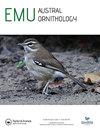Emu–Austral Ornithology in the era of Twitter: 120 years of regional ornithology and counting
IF 1.1
4区 生物学
Q3 ORNITHOLOGY
引用次数: 1
Abstract
This year, Emu–Austral Ornithology turns 120. As one of the oldest of the world’s ornithological journals, it has flown on through several major storms. Like the big (flightless!) bird itself (e.g. Ryeland et al. 2021), the journal has had to adapt to ever more rapid change. It continues to reflect BirdLife Australia’s policy to promote the celebration, understanding and conservation of austral birds (Buchanan and Herman 2021), and across the years has tracked significant conceptual changes in international ornithological science (Joseph et al. 2021). The journal began embedded in an idea for a national organisation devoted to birds, hatched over several gettogethers of oologists, at which ‘nothing stronger than tea and coffee was drunk’ (Anon 1901a). In 1901, this sober clutch founded the Australasian Ornithologists’ Union (now BirdLife Australia), in hopes of uniting the region’s ornithological interests, just as the concurrent Federation sought to unite the Australian colonies. One of the objects of the new union was to publish a ‘magazine called The Emu’ (Anon 1901b), through which ‘bird students will be kept in touch with one another, original study will be aided, and an Australian want supplied’ (Anon 1901a). The choice of the name Emu was not just biological, but also political and cultural (Robin 2002). Since hatching, Emu–Austral Ornithology (hereafter usually shortened to Emu) has survived two World Wars, the Depression and gradual shifts and more controversial changes. An example of the later was the socalled ‘revolution’ of the late 1960s, a reform intended to push the journal from semi-popular to fully scientific (i.e. of international standard) with the approach of the 1974 International Ornithological Congress (IOC), to be held for the first time in Australia (Marchant 1972; Robin 2002). In recognition of the journal’s centenary, Robin’s ‘The Flight of the Emu: A Hundred Years of Australian Ornithology 1901–2001ʹ (2001) thoroughly synthesised its history, in the context of organisational and societal change. Two overviews appeared in the special centennial edition of the journal (Olsen 2002; Robin 2002). Earlier reviews were tackled by sometime influential editors Dom Serventy and Stephen Marchant. The former championed amateurs – until then the predominant contributors – as pioneers who built a strong knowledge base at a time when there were few trained researchers (Serventy 1972). The later took a more critical view, suggesting the journal and its contributors had not kept up with the times, notably the high standards expected internationally and by the growing professional community in Australia (Marchant 1972). As observed by Robin (2002): ‘One of Emu’s greatest strengths is now its long history.’ In the two decades since the centenary, three detailed bibliometric analyses have been published of different aspects of the journal’s contents over time (Yarwood et al. 2014, 2019; Weston et al. 2020) and there have been two major administrative changes (Saunders et al. 2001; Herman and Buchanan 2017). These offer insights into the development of ornithology in Australia, its relationship to local and global developments in society and to the scientific and publishing worlds. Such analyses can also identify knowledge gaps or imbalances in content or contributors, and can be used to direct and guide future research effort and acceptable methodologies, and improve representation and equity.推特时代的鸸鹋-南方鸟类学:120年的地区鸟类学和计数
今年,鸸鹋-南方鸟类学迎来了120岁生日。作为世界上最古老的鸟类学期刊之一,它经历了几次大风暴。就像大(不会飞的!)鸟一样(例如Ryeland et al. 2021),期刊不得不适应越来越快的变化。它继续反映了澳大利亚国际鸟盟促进庆祝,了解和保护南方鸟类的政策(布坎南和赫尔曼2021),多年来一直追踪国际鸟类学科学的重大概念变化(约瑟夫等人2021)。这本杂志开始植根于一个致力于鸟类研究的国家组织的想法,这个想法是在几次动物学家的聚会上酝酿出来的,在这些聚会上“没有什么比茶和咖啡更浓烈的了”(Anon 1901a)。1901年,这个清醒的团体成立了澳大利亚鸟类学家联盟(现在的澳大利亚鸟类联盟),希望团结该地区的鸟类学利益,就像当时的联盟试图团结澳大利亚殖民地一样。新联盟的目标之一是出版一本“名为《鸸鹋》的杂志”(Anon 1901b),通过这本杂志,“鸟类研究人员将彼此保持联系,帮助原创研究,并提供澳大利亚需求”(Anon 1901a)。选择鸸鹋这个名字不仅仅是生物学上的,也是政治和文化上的(Robin 2002)。自孵化以来,鸸鹋-南方鸟类学(以下通常简称为鸸鹋)经历了两次世界大战、大萧条和逐渐的转变和更有争议的变化。后者的一个例子是20世纪60年代末所谓的“革命”,一项旨在推动期刊从半流行到完全科学(即国际标准)的改革,采用了1974年国际鸟类学大会(IOC)的方法,首次在澳大利亚举行(1972年3月;罗宾2002)。为了纪念该杂志成立一百周年,罗宾的《鸸鹋的飞行:1901-2001年澳大利亚鸟类学百年》(2001)在组织和社会变革的背景下,彻底地综合了它的历史。两篇综述发表在该杂志的百年特刊上(Olsen 2002;罗宾2002)。早期的评论是由一些有影响力的编辑Dom Serventy和Stephen Marchant处理的。前者支持业余爱好者——在那之前,业余爱好者是主要的贡献者——在训练有素的研究人员很少的时候,他们是建立强大知识库的先驱(Serventy 1972)。后者则持更为批判的观点,认为该期刊及其撰稿人没有跟上时代的步伐,尤其是没有达到国际上和澳大利亚日益增长的专业团体所期望的高标准(1972年3月)。正如罗宾(2002)所观察到的:“现在,欧洲货币联盟最大的优势之一是它悠久的历史。在百年纪念以来的二十年里,已经发表了三份详细的文献计量分析,分析了该期刊内容的不同方面(Yarwood等人,2014年,2019年;Weston et al. 2020),并且有两个主要的行政变化(Saunders et al. 2001;Herman and Buchanan 2017)。这些提供了对澳大利亚鸟类学发展的见解,以及它与当地和全球社会发展以及科学和出版界的关系。这种分析还可以确定内容或贡献者方面的知识差距或不平衡,并可用于指导和指导未来的研究工作和可接受的方法,并改善代表性和公平性。
本文章由计算机程序翻译,如有差异,请以英文原文为准。
求助全文
约1分钟内获得全文
求助全文
来源期刊

Emu-Austral Ornithology
生物-鸟类学
CiteScore
2.00
自引率
7.70%
发文量
33
审稿时长
>12 weeks
期刊介绍:
Emu – Austral Ornithology is the premier journal for ornithological research and reviews related to the Southern Hemisphere and adjacent tropics. The journal has a long and proud tradition of publishing articles on many aspects of the biology of birds, particularly their conservation and management.
 求助内容:
求助内容: 应助结果提醒方式:
应助结果提醒方式:


